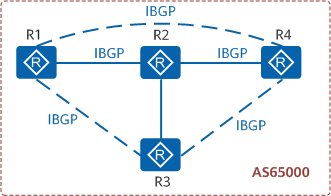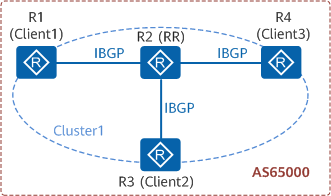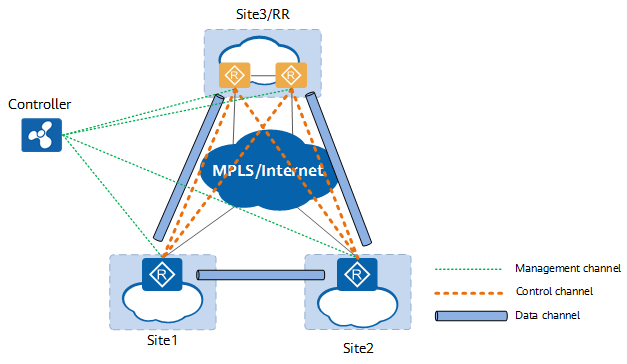What Is an RR?
A route reflector (RR) can be deployed on a large-scale BGP network to solve the problem of full-mesh IBGP connections.
As a special IBGP router, an RR can store routing entries on the entire network and redistribute routing information to other IBGP routers.
Why Is an RR Needed?
On a traditional IBGP network, to prevent routing loops, an IBGP device does not advertise routes learned from an IBGP peer to other IBGP peers. To ensure connectivity between IBGP peers, logical full-mesh connections need to be established between IBGP peers.

Full-mesh IBGP connections on an IBGP network
As required by IBGP, R2 does not advertise the routes learned from R1 to R3. To enable R1 and R3 to advertise routes to each other, an IBGP connection (a dotted line) needs to be established between R1 and R3 so that R1 and R3 become IBGP peers. Similarly, to ensure connectivity between IBGP peers in the same autonomous system (AS), IBGP connections also need to be established between R1 and R4, and between R3 and R4. If there are N IBGP devices in an AS, the number of IBGP connections to be established is N x (N–1)/2. When there are a large number of devices, a large number of network resources and CPU resources are consumed. To address this issue, an RR can be used. This reduces the number of established connections to the value of N–1, effectively saving network resources and device CPU resources.
Working Principles of an RR
In Figure 1-3, the following roles are involved in an AS with an RR deployed:
- RR: A BGP device that can reflect the routes learned from an IBGP peer to other IBGP peers.
- Client: An IBGP device whose routes are reflected by the RR to other IBGP devices.
- Cluster: A set of the RR and clients.
Clients in a cluster need to exchange routing information only with the RR in the cluster. Therefore, clients need to establish IBGP connections only with the RR. This reduces the number of IBGP connections in the cluster. In the preceding figure, in AS65000, R2 functions as an RR, while R1, R3, and R4 function as clients, forming Cluster1. R1 can obtain routing information of R3 and R4 through the RR. The same rule applies to R3 and R4. The number of IBGP connections in AS65000 is then reduced from 6 to 3, which simplifies the device configuration and reduces the loads on the network and CPU.
The RR advertises the routes learned from a client to all other clients, preventing an IBGP device from advertising the routes learned from an IBGP peer to other IBGP peers.
RR Application Scenarios
With the extension of BGP, BGP has been widely used, and RRs have been used in an increasing number of scenarios, such as software-defined wide area network (SD-WAN).
In Figure 1-4, the RR is a part of the SD-WAN control layer, being responsible for controlling and transmitting VPN routes and topology information on the entire network. The RR works with the controller to distribute VPN routes and topology information between sites based on user-defined policies, implementing on-demand interconnection between sites.
The following describes the functions of the RR on an SD-WAN network.
- Devices at the three sites register with the controller to establish management channels. The controller allocates an RR to each device at Site1 and Site2 through a management channel. The RRs for Site1 and Site2 belong to Site3 (RR site).
- Site1 and Site2 obtain RR site information through management channels and connect to the RR site.
- Site1 and Site2 advertise their routing information to the RRs through the connections established with the RRs. The RRs also advertise its routing information to Site1 and Site2. Then, a control channel, also called a BGP EVPN connection, is established between both ends.
- BGP peer relationships have been established between the RR site and Site1, and between the RR site and Site2. If the controller requires a data channel to be established between Site1 and Site2, the controller can instruct an RR to reflect the routing information received from Site1 to Site2 and reflect the routing information received from Site 2 to Site 1. In this way, Site1 and Site2 can obtain the routing information of each other and establish a data tunnel between them. When Site1 advertises a new route, Site2 can still learn the new route through the RR.
- As the RR reflects routes learned from a client to all other clients, in SD-WAN scenarios, the controller can instruct the RR to reflect routes to specific non-RR sites. For example, to prevent a data channel from being established between Site1 and Site2, the networking topology can be modified on the controller so that the RR does not reflect the routing information of Site1 to Site2.
To sum up, although BGP has an increasing number of extended protocols and carries more routing information, an RR still functions as the regional center in an area to reflect routing information received from a device to other devices. This reduces network management and transmission costs, improves network management efficiency, and provides high network stability.
- Author: Ding Heng
- Updated on: 2023-08-16
- Views: 2130
- Average rating:









